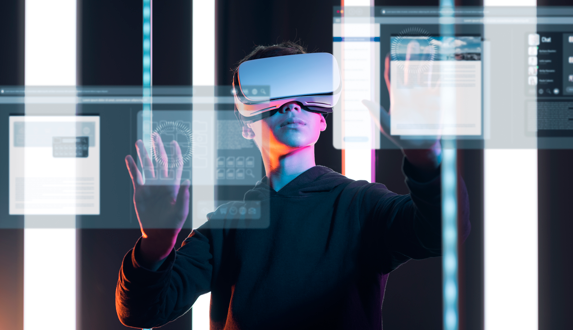Every day millions of users connect online and socialize in real time across various virtual universes: the Metaverse, as experienced and analyzed in our previous article, already exists as an experience. In fact, multiplayer online gaming platforms are now considered an integral part of the Metaverse, being a fusion of video games and real-time social networking. R&D and recent technological innovations have improved the experience offered by visors, making it even more real and engaging.
However, why is Metaverse technology, which connects the real world with the digital, seen as the next frontier of our online interactions? What makes it so unique compared to traditional digital?
Table of contents:
- Engagement
- Socialization
- Digital Ownership
- Immersion
- Contextual Intelligence
- Dematerialization
Engagement
Engagement is definitely one of the key aspects of the Metaverse. The more engaging a virtual universe is, the more time users will spend in it. Take, for example, worlds such as Minecraft, Roblox or Fortnite: these are platforms born primarily with the goal of entertaining.
There is no point in going around it: today at the center of the Metaverse concept we find video games. It is an industry worth about $200 billion, far surpassing movies and music combined. The spread of smartphones has allowed video games to reach half the world’s population. In fact, virtual worlds are primarily a subcategory of video games, online multiplayer video games, which connect people from all over the world in real time.
In 2019, Tim Sweeny, the CEO of Epic Games-the creator of Fortnite-when asked if Fortnite was just a game, replied, “Fortnite is a game. But ask me again in 12 months.” After just one year, as many as 27.7 million individuals have watched Travis Scott’s virtual concert on Fortnite in 2020. These platforms, in fact, go beyond pure gaming: they are virtual places within which to organize all kinds of immersive experiences. We are talking, for example, about concerts, immersive artwork, creative experiences, immersive 3D storytelling.
Socialization
The second foundation of the Metaverse is undoubtedly socialization. These platforms offer the ability to emulate everyday social interactions, such as attending events, exhibitions, concerts, and ceremonies, always with a focus on collective experience. These are virtual places where individuals not only play, but meet, communicate and interact as they do in the physical world. Looking at it from this angle, these virtual universes are far more compelling than traditional social media, where interactions occur post-posting and are more passive (platforms such as TikTok are increasingly likened to TV channels rather than real social areas). Mark Zuckerberg recognized this trend early: these virtual worlds are a cross between entertainment and social media, marking the new era of digital socialization.
The data confirm this. Today Roblox has 67.3 million daily active users and about 214 million monthly active users, mainly young people. Fortnite boasts over 250 million monthly active users. These two titles alone attract nearly half a billion people per month. And their users don’t just play games: about 50 percent of GenZ enter these virtual universes without the intention of playing the main game (source: Newzooo Mini Survey: Metaverse and VR). And if we look at these platforms as real “meeting places,” albeit virtual, we understand that this is a natural trend. In the real world, upon closer inspection, the same thing happens. In moti gather in spaces dedicated to entertainment to socialize, but without necessarily participating in the main activity: not everyone consumes drinks at the bar, not everyone goes wild at the disco, not everyone goes bowling. Although virtual, in the Metaverse we maintain our usual social tendencies.
Digital Ownership
While our tendencies as individuals remain constant, so do our needs: we want to differentiate ourselves, express our individuality and convey messages that relate in some way to our status. As new generations spend more and more time in these virtual universes, the need to see their identity reflected grows. In this vast digital ocean, each person wants to personalize his or her “digital self,” or avatar, to show a distinctive aspect of self. It is not surprising, then, that the first industries to enter these virtual worlds are those related to the fashion and luxury industries.
These virtual spaces have rapidly evolved into full-fledged virtual economic ecosystems, where you can buy products, services, spaces and experiences, and where, in particular, you can showcase your digital designs-just as we would in the tangible world. Hence a third key pillar of the Metaverse: digital ownership.
However, to facilitate these valuable transactions within virtual economies, payment technologies are needed. There are traditional systems, the ones we routinely use for transactions in digital stores (such as the App Store on our phone). But there are also new emerging technologies, such as blockchain, that aim to transform how these digital economies work, making them decentralized. Blockchain makes it possible to decentralize the holding of data without having to depend on (and pay fees to) giants like Apple or Google, which currently facilitate transactions in these virtual environments. It is through the blockchain that we have cryptocurrencies, digital currencies used for transactions; and, most importantly, NFTs (Non Fungible Tokens), which are unique digital certificates that attest to authenticity and provenance and which, when associated with an object in the Metaverse, make it unique and, consequently, tradable.
Immersion
The fourth pillar of the Metaverse is identified with Immersion: with the advent of increasingly advanced virtual reality technologies, the representation of reality now appears more realistic and efficient, making it more immersive, able to evoke in us emotions comparable to those experienced in the real world. This is a complete immersion, a genuine placebo effect for our minds.
Numerous research studies highlight the effectiveness and impact of virtual reality on the human brain. One of the most relevant studies is the Einstein Embodiment, conducted by a group of scholars at the Department of Clinical Psychology and Psychobiology at the University of Barcelona. The survey involved 30 participants between the ages of 18 and 30. After a series of cognitive tests and solving challenges, it was found that those who had experienced “being in Einstein’s shoes” had significantly higher performance. Further analysis revealed a connection between increased self-esteem and cognitive improvement: basically, they had shown signs of higher intelligence!
The potential of virtual reality is extraordinary, and its applications go far beyond the field of neuroscience. When we enter these digital universes through a VR visor, we can also physically interact, moving, running and even sweating, becoming an active part of a real workout-as can be experienced in Tennis League VR, a virtual reality tennis simulator created by AnotheReality and H.I.P.
Contextual Intelligence
The fifth pillar of the Metaverse takes us directly into a much-discussed area of technology recently: (Artificial) Intelligence. If in fact these virtual worlds are mainly populated by avatars governed by real human beings, already today within them it is easy to run into the so-called NPCs (Non Playing Characters) or AVIs (Intelligent Virtual Agents). These are nothing more than avatars guided by forms of Artificial Intelligence of varying complexity, with whom you can interact exactly as you would with a chatbot. Stephenson himself, in devising his Metaverse, envisioned populating it with “demons,” incredibly advanced virtual assistants, similar to that ChatGPT with which many are now familiar.
However, thanks to the power of augmented reality to contextualize information about the physical world in real time, Artificial Intelligence is combining with Contextualization to open up new and disruptive scenarios. For example, these “artificial beings” will spread into the real world, perhaps turning our animal friends into artificial entities, as proposed by projects such as Peridot (created by Niantic, the same company behind Pokemon Go). Virtual pets-doesn’t that sound like an evolution of the good old Tamagotchi? And again think of the possibility of adding “subtitles” to the real world, giving even the deaf the chance to know exactly what the people around them are saying. Or the world of digital twins: we will be able to look at any object in the physical world and have contextual information about its operation, and most importantly, we will be able to know-thanks to the use of simulations-when that product will fail, thus being able to intervene promptly with required maintenance activities before a problem actually manifests itself.
Dematerialization
If many items will take on a new intelligence, many more … will become invisible. The sixth pillar of the Metaverse is closely related to dematerialization. Through advanced simulation technologies, 3D worlds and, in particular, XR (eXtended Realities), we can already dematerialize almost any object, environment or even individual. Although this peculiarity is clearly visible in virtual reality, we will feel its true potential with augmented or mixed reality, tools that allow us to “augment” reality with contextual and interactive details in real time. We thus speak of authentic holograms, highly realistic three-dimensional representations that interact with physical space, merging with it.
In his June 22, 2015 email note to his shareholders, Zuckerberg claims, “when we have a good AR/VR system, we will no longer need to buy phones, televisions, or many other physical objects-they will simply become apps in a digital store.” As the Metaverse evolves, and particularly as augmented reality expands, many objects we now consider tangible will be dematerialized, turning into manipulable, replicable holograms in space. They will take the form of software, just as happened to DVDs, CDs, documents and books, which have now become, for the most part, mere digital files. With the Metaverse, much of our environment could quickly turn into an app, and the consequences of this dematerialization on our daily existence will initially be revolutionary and, shortly thereafter, almost indispensable.


